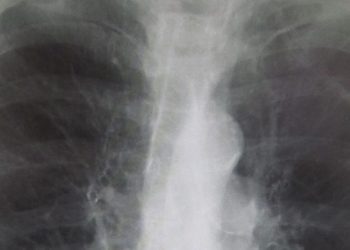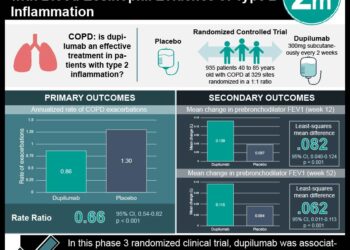Defining airflow obstruction as FEV1:FVC of less than 0.70 optimal compared to other fixed thresholds for COPD
1. In this retrospective cohort study, an FEV1:FVC threshold of 0.71 was the best fit for discriminating COPD-related events, though it was not statistically different than using 0.70.
2. The FEV1:FVC 0.70 threshold provided optimal discrimination in a subgroup analysis of ever smokers and in adjusted models.
Evidence Rating Level: 2 (Good)
Study Rundown: Current respiratory society guidelines recommend diagnosing airflow obstruction when the ratio of the forced expiratory volume in the first second to the forced vital capacity (FEV1:FVC) is less than a fixed threshold of 0.70. However, there is little empirical data supporting this cut-off versus others, such as the lower-limit of normal (LLN) based on demographic and clinical factors. In this retrospective cohort, the accuracy of various FEV1:FVC fixed thresholds for predicting COPD-related hospitalization and mortality was investigated. An FEV1:FVC threshold of 0.71 was the best fit for discriminating COPD-related events, though it was not statistically different than using 0.70. However, the 0.70 threshold did have better discriminative accuracy than the LLN. The FEV1:FVC 0.70 threshold provided optimal discrimination in a subgroup analysis of ever smokers and in adjusted models.
While this study suggests that the 0.70 threshold is appropriate for COPD, some limitations should be noted. For instance, GOLD (Global Initiative for Chronic Obstructive Lung Disease) guidelines recommend using post-bronchodilator values for confirming airflow obstruction, while this study used pre-bronchodilator spirometry. Further, there were no adjustments made for medication use. Finally, the composite of COPD-related hospitalization and mortality was selected as the primary outcome and probably excluded a large number of participants with mild-to-moderate disease who suffer exacerbations.
Click to read the study in JAMA
Click to read an accompanying editorial in JAMA
Relevant Reading: Increased Accuracy After Adjustment of Spirometry Threshold for Diagnosing COPD Based on Pre-Bronchodilator FEV1/FVC.
In-Depth [retrospective cohort]: The National Heart, Lung, and Blood Institute Pooled Cohorts Study included 24,207 participants from 4 US general population–based cohorts. The primary outcome was a composite of COPD-related mortality and COPD-related hospitalization. Analyses were conducted on FEV1:FVC thresholds 0.65 to 0.75 and the LLN> In the primary analysis, the 0.71 FEV1:FVC threshold demonstrated the highest C-statistic (0.696; CI95 0.688 to 0.703). The 0.71 discrimination threshold was not significantly different from the 0.70 threshold (difference 0.001; CI95 −0.002 to 0.004). It was significantly more accurate than the LLN threshold (difference 0.034; CI95, 0.028 to 0.041). The sensitivity for the LLN was 52%, and the specificity for the LLN was 89%, which approximated the results for a fixed 0.66 threshold. The 0.70 threshold had a sensitivity of 66%, and the specificity was 79%. The optimal fixed threshold was 0.70 in ever smokers and in men, 0.71 for COPD-related hospitalizations, and 0.69 for the events for which COPD was the primary or underlying cause.
Image: PD
©2019 2 Minute Medicine, Inc. All rights reserved. No works may be reproduced without expressed written consent from 2 Minute Medicine, Inc. Inquire about licensing here. No article should be construed as medical advice and is not intended as such by the authors or by 2 Minute Medicine, Inc.








